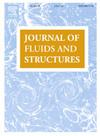用混合方法分析低马赫数流中自激振荡圆柱的气动和声学特性
IF 3.4
2区 工程技术
Q1 ENGINEERING, MECHANICAL
引用次数: 0
摘要
置于低雷诺数流中的圆柱体可能会导致不稳定,例如不稳定的流体诱导力和结构的非周期性振动,从而导致疲劳载荷增加。它还会产生明显的流致噪声。因此,了解这种结构的振动行为及其声传播机制至关重要。本文研究了在Ma = 0.2, Re = 150, m* = 5条件下横向自激振荡圆柱的空气动力学和声学特性。为了简化问题,我们采用质量-弹簧-阻尼系统对气缸的运动进行建模,并采用Newmark-β方法求解运动轨迹。推导了运动网格下粘声劈裂法的声学控制方程,并与直接数值模拟结果进行了对比验证。关键参数包括振幅比、频率比、升力和阻力系数,以及升力和位移之间的相位角,分析范围从降低速度Ur = 2到Ur = 9。观察到各种旋涡引起的振动现象,如“锁定”、“相位切换”和“跳动”。预测的声音信号在初始分支、下分支和非同步分支之间表现出明显的变化:振动对初始分支声场的影响最小,初始分支和下分支之间存在“跳动”现象,由于下分支阻力的突然增加导致声场旋转,以及由于抑制涡脱落而降低了非同步分支的声波强度。本文章由计算机程序翻译,如有差异,请以英文原文为准。
Aerodynamic and acoustic analysis of a self-excited oscillation cylinder in a low Mach flow using a hybrid method
A cylinder placed in low Reynolds number flows can cause instabilities, such as unstable fluid induced forces and non-periodic vibrations of structures, leading to increased fatigue loading. It can also generate significant flow-induced noise. Therefore, understanding the vibrational behavior and its acoustic propagation mechanism in this configuration is crucial. This study investigates the aerodynamics and acoustic characteristics of a transversely self-excited oscillating circular cylinder at Ma = 0.2, Re = 150 and m* = 5. To simplify the problem, we model the movement of the cylinder using a mass-spring-damper system and solve the motion trajectory using the Newmark-β method. The acoustic governing equations formulated within viscous/acoustic splitting method in terms of a moving mesh are derived and validated by comparison with the direct numerical simulation method results. Key parameters, including amplitude ratio, frequency ratio, lift and drag coefficients, and phase angle between lift and displacement were analyzed over a range from reduced velocity Ur = 2 to Ur = 9. Various vortex-induced vibration phenomena, such as "lock-in," "phase switching," and "beating," are observed. The predicted sound signal exhibits distinct variations across the initial, lower and desynchronization branches:minimal impact of vibration on the acoustic field in the initial branch, a "beating" phenomenon between the initial and lower branches, the acoustic field rotation due to a sudden increase in drag force in the lower branch, and reduced acoustic wave intensity in the desynchronization branch due to vortex shedding suppression.
求助全文
通过发布文献求助,成功后即可免费获取论文全文。
去求助
来源期刊

Journal of Fluids and Structures
工程技术-工程:机械
CiteScore
6.90
自引率
8.30%
发文量
173
审稿时长
65 days
期刊介绍:
The Journal of Fluids and Structures serves as a focal point and a forum for the exchange of ideas, for the many kinds of specialists and practitioners concerned with fluid–structure interactions and the dynamics of systems related thereto, in any field. One of its aims is to foster the cross–fertilization of ideas, methods and techniques in the various disciplines involved.
The journal publishes papers that present original and significant contributions on all aspects of the mechanical interactions between fluids and solids, regardless of scale.
 求助内容:
求助内容: 应助结果提醒方式:
应助结果提醒方式:


